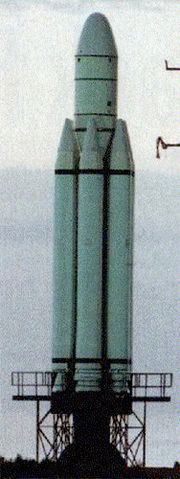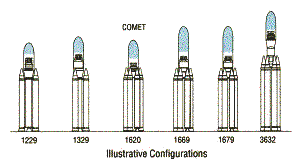
Conestoga (rocket)
Encyclopedia


Rocket
A rocket is a missile, spacecraft, aircraft or other vehicle which obtains thrust from a rocket engine. In all rockets, the exhaust is formed entirely from propellants carried within the rocket before use. Rocket engines work by action and reaction...
consisting originally of surplus Minuteman missile stages with additional strap-on boosters, as required, for larger payloads. It was the world's first privately-funded commercial rocket, but was used only three times (one as a modified design) before the program was shut down due to a lack of business.
Conestoga was design funded by Space Services Inc.
Space Services Inc.
Space Services, Inc. of America is a space services company that provides star naming services as well as space memorial services through its subsidiary company, Celestis...
of America (SSIA) of Houston, Texas
Houston, Texas
Houston is the fourth-largest city in the United States, and the largest city in the state of Texas. According to the 2010 U.S. Census, the city had a population of 2.1 million people within an area of . Houston is the seat of Harris County and the economic center of , which is the ...
. They had originally intended to use a design by Gary Hudson
Gary Hudson
Gary Hudson has been involved in private spaceflight development for over 25 years.Hudson is best known as the founder of Rotary Rocket Company, which in spending ~$30 Million attempted to build a unique single stage to orbit launch vehicle known as the Roton...
, Percheron, which was intended to dramatically lower the price of space launches. Key to the design was a simple pressure-fed kerosene-oxidizer engine that was intended to reduce the costs associated with "throwing away" the booster. Various loads could be accommodated by clustering the basic modules together. SSIA conducted an engine test firing of the Percheron from Matagorda Island
Matagorda Island
Matagorda Island, Spanish for "thick brush," is a 38 mile long barrier island on the Texas Gulf coast, about seven miles south of Port O'Connor, in the southernmost part of Calhoun County. The island is oriented generally northeast-southwest, with the Gulf of Mexico on the east and south, and...
on August 5, 1981, but the rocket exploded on the pad due to a malfunction. SSIA then parted ways with Hudson.
SSIA founder David Hannah then hired Deke Slayton
Deke Slayton
Donald Kent Slayton , better known as Deke Slayton, was an American World War II pilot and later, one of the original NASA Mercury Seven astronauts....
, one of the original Mercury Seven
Mercury Seven
Mercury Seven was the group of seven Mercury astronauts selected by NASA on April 9, 1959. They are also referred to as the Original Seven and Astronaut Group 1...
astronauts. Slayton had just left NASA
NASA
The National Aeronautics and Space Administration is the agency of the United States government that is responsible for the nation's civilian space program and for aeronautics and aerospace research...
after running (among earlier roles) the Space Shuttle
Space Shuttle
The Space Shuttle was a manned orbital rocket and spacecraft system operated by NASA on 135 missions from 1981 to 2011. The system combined rocket launch, orbital spacecraft, and re-entry spaceplane with modular add-ons...
Landing and Approach validation testing. They came up with an entire new design based on clustering engines from the second stage of the Minuteman missile. The first launch of the new Conestoga I design took place on 9 Sep 1982, consisting of the core missile stage and a 500 kg dummy payload which included 40 gallons of water. The payload was successfully ejected at 313 km, and the Conestoga I became the first privately funded rocket to reach space.
SSIA launched a second rocket in 1989, turning to commercial support for microgravity experiments, using the Black Brant
Black Brant (rocket)
The Black Brant is a Canadian-designed sounding rocket built by Bristol Aerospace in Winnipeg, Manitoba. Over 800 Black Brants of various versions have been launched since they were first produced in 1961, and the type remains one of the most popular sounding rockets ever built...
sounding rocket
Sounding rocket
A sounding rocket, sometimes called a research rocket, is an instrument-carrying rocket designed to take measurements and perform scientific experiments during its sub-orbital flight. The origin of the term comes from nautical vocabulary, where to sound is to throw a weighted line from a ship into...
which they referred to as "Starfire".
SSIA was purchased by EER Systems in December 1990. The design was modified again, this time using the Castor engines originally used on the Scout
Scout (rocket)
The Scout family of rockets were launch vehicles designed to place small satellites into orbit around the Earth. The Scout multistage rocket was the first orbital launch vehicle to be entirely composed of solid fuel stages....
, a workhorse of the 1960s. The new design was known as the Conestoga 1620, or by other numbers depending on the number and arrangement of the boosters.
In May 1990 the Center for Space Transportation and Applied Research (CSTAR) pitched NASA on their Commercial Experiment Transporter (COMET) payload concept, a low-cost standardized bus with both sub-orbital and orbital components. Rides on the COMET promised to be longer than existing sounding rockets, and the orbital portion would be free-flight and thus not disturbed by crew movement as it was on the Space Shuttle
Space Shuttle
The Space Shuttle was a manned orbital rocket and spacecraft system operated by NASA on 135 missions from 1981 to 2011. The system combined rocket launch, orbital spacecraft, and re-entry spaceplane with modular add-ons...
. Westinghouse
Northrop Grumman Electronic Systems
' was created by Northrop Grumman's acquisition of Westinghouse Electronic Systems Group in 1996. The Electronic Systems sector is a leading designer, developer, and manufacturer of a wide variety of advanced defense electronics and systems. The division has 120 locations worldwide, including 72...
agreed to provide the bus and "service module", Space Industries Inc. built the re-entry module, and EER was contracted to provide several Conestoga launchers.
The entire COMET program quickly ran into delays and budget overruns, and it was not until the end of the program that a COMET (now known as METEOR) and Conestoga 1620 were finally ready for launch. The satellite payload included a number of experiments, including materials (evaluate exposure to the caustic space environment), biological (assessment of seed reaction in micro-gravity; growth fluids were to be injected to the seed containers after launch), as well as GPS/radar correlation tracking. The satellite included a recoverable section that was to separate on command after several weeks on orbit, fire a small internal retro-motor, and descend for a recovery off the Virginia coast. The launch took place from the a special clamshell gantry, which included power and environmental controls, at the south end of Wallops Flight Facility
Wallops Flight Facility
Wallops Flight Facility , located on the Eastern Shore of Virginia, is operated by NASA’s Goddard Space Flight Center, primarily as a rocket launch site to support science and exploration missions for NASA and other U.S. government agencies...
on 23 October 1995; the rocket launched normally, but broke up in-flight 46 seconds later. EER concluded that an unknown source of low frequency noise caused the guidance system to order course corrections when none were needed, eventually causing the steering mechanism to run out of hydraulic fluid. An earlier NASA review had already decided to refuse further funding due to the original delays, and EER subsequently got out of the rocket business. It was purchased by L-3 Communications
L-3 Communications
L-3 Communications Holdings, Inc. is a company that supplies command and control, communications, intelligence, surveillance and reconnaissance systems and products, avionics, ocean products, training devices and services, instrumentation, space, and navigation products. Its customers include...
in 2001 for $110 million.
Versions
Due to the modular design of the Conestoga, a large number of configurations were possible. Therefore the version number encoded the configuration:- the first digit encoded the type of rocket motor used in the cluster
- the second was the number of motors clustered around the core
- the third was the type of the first upper stage
- the fourth was the type of the second upper stage
| Version | Stages | Stage 1 | Stage 2 | Stage 3 | Stage 4 | Stage 5 | Payload (kg) |
|---|---|---|---|---|---|---|---|
| Conestoga 1229 | 4 | 2 Castor-4B | 1 Castor-4B | Star-48V | HMACS | - | 363 kg |
| Conestoga 1379 | 4 | 3 Castor-4B | 1 Castor-4B | Star-63V | HMACS | - | 770 kg |
| Conestoga 1620 | 4 | 4 Castor-4A/B | 2 Castor-4B | 1 Castor-4B | Star-48V | - | 1179 kg |
| Conestoga 1669 | 5 | 4 Castor-4A/B | 2 Castor-4B | 1 Castor-4B | Star-63D | HMACS | 1361 kg |
| Conestoga 1679 | 5 | 4 Castor-4A/B | 2 Castor-4B | 1 Castor-4B | Star-63V | HMACS | 1497 kg |
| Conestoga 3632 | 5 | 4 Castor-4A/B-XL | 2 Castor-4B-XL | 1 Castor-4B-XL | Orion-50 | Star-48V | 2141 kg |


